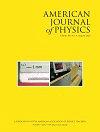磁超频相互作用变得更容易
IF 0.8
4区 教育学
Q3 EDUCATION, SCIENTIFIC DISCIPLINES
引用次数: 0
摘要
我们介绍了利用经典电动力学对氢基态超细相互作用的两种推导。我们在质子矩 m→p 处计算了相对扩展的 1 s 电子态的磁化源 M→e(r→)所产生的磁场 B→e。这就得到了-m→p-B→e 的磁相互作用。一种推导是将比奥特-萨瓦特定律应用于束缚 1 s 电流 J→b=∇→×M→,直接求出 B→e;另一种推导是将库仑定律的磁场版本应用于束缚 1 s 磁荷密度 ρb=-∇→-M→ ,首先求出 μ0H→e ,然后加上 μ0M→ 求出 B→e。我们证明,对于任何源 M→,这两种方法都能得到相同的 B→(r→),正如经典电动力学所预期的那样。本文章由计算机程序翻译,如有差异,请以英文原文为准。
Magnetic hyperfine interaction made easier
We present two derivations of the hyperfine interaction in the ground state of hydrogen using classical electrodynamics. We calculate, at the site of the proton moment m→p, the magnetic field B→e due to the magnetization source M→e(r→) of the relatively extended 1 s electron state. This gives the magnetic interaction via −m→p·B→e. One derivation applies the Biot–Savart law to the bound 1 s electric current J→b=∇→×M→ to directly find B→e; the other derivation applies the magnetic version of the Coulomb Law to the bound 1 s magnetic charge density ρb=−∇→·M→ to first obtain μ0H→e and then adds μ0M→ to find B→e. We show, for any source M→, that these two approaches give the same B→(r→), as is expected within classical electrodynamics.
求助全文
通过发布文献求助,成功后即可免费获取论文全文。
去求助
来源期刊

American Journal of Physics
物理-物理:综合
CiteScore
1.80
自引率
11.10%
发文量
146
审稿时长
3 months
期刊介绍:
The mission of the American Journal of Physics (AJP) is to publish articles on the educational and cultural aspects of physics that are useful, interesting, and accessible to a diverse audience of physics students, educators, and researchers. Our audience generally reads outside their specialties to broaden their understanding of physics and to expand and enhance their pedagogical toolkits at the undergraduate and graduate levels.
 求助内容:
求助内容: 应助结果提醒方式:
应助结果提醒方式:


